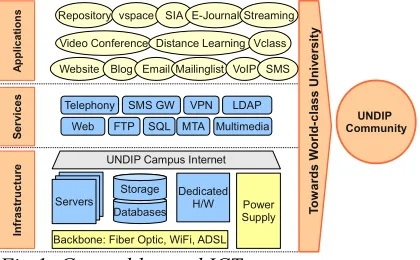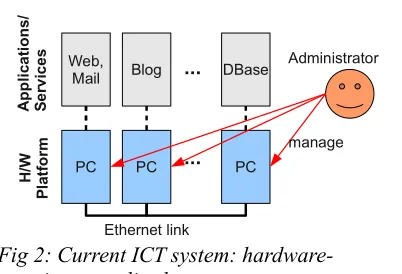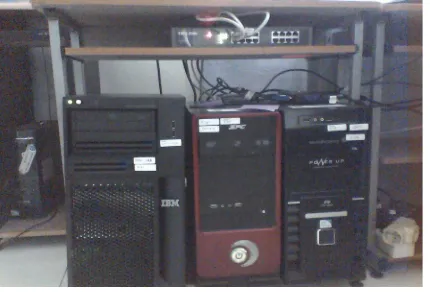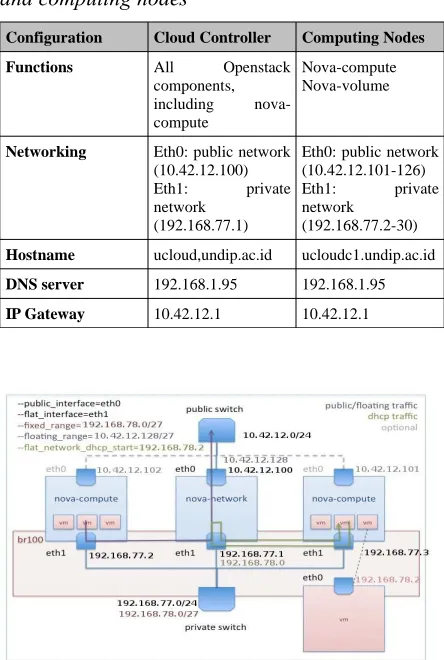CAMPUS CLOUD COMPUTING TESTBED AT DIPONEGORO
UNIVERSITY
Adian Fatchur Rochim1 and Eko Didik Widianto2
1,2 Department of Computer System Engineering, Diponegoro, Semarang 50275 Indonesia
ABSTRACT
This paper aims to develop a cloud computing testbed on Undip campus. The testbed will be used as a reliable and a scalable ICT infrastructure for Undip servers, such as web, repository and database servers. Each server is implemented by using Ubuntu server OS and run on a virtual machine. Virtual machines are generated from the virtual infrastructure by KVM hypervisor. The testbed implements one computer as the cloud server and two computers as the computing nodes. It gives three virtual machines which run web server, Ubuntu repository server, and SQL database server. Testing of its functionality, reliability and scalability is performed by deploying and operating the cloud system on testbed that connected to Undip global network. The system ability to increase or decrease its resource capacity shows that it is ready to use it as the next-generation of Undip ICT infrastructure.
Keywords: cloud computing, virtualization, ICT infrastructure, testbed, Infrastructure as A Service
1. INTRODUCTION
Diponegoro University (Undip) has a vision to become an excellent research university in 2020 [1]. One of the strategic missions is to implement ICT-based system to deliver value-added services and applications for Undip community to become more productive, creative and expressive.
The development of ICT system for Undip community done in 3 layers (see Figure 1): 1) physical infrastructure layer, 2) services layer and 3) applications layer. Physical infrastructure includes computer servers, storage, database and its network devices and links. The infrastructure provides a hardware platform for services, community, including repository, e-journal, website, blog, email, Voice over Internet Protocol (VoIP), SMS, etc.
Currently, many ICT applications have been deployed and become the backbone to achieve Undip vision as a research and world class
university. These applications include web server for university, faculties and departments sites, blogs (for teacher, student), email, mailing list, VoIP, SMS broadcast, video conference, distance learning, virtual classrooms, repository, virtual storage for data / file, academic information systems and electronic journals. For these rich and value-added applications, Undip has been awarded as winner of TESCA (Telkom Smart Campus Award) in the category of The Most Application Portfolio Local Node by PT. Telkom Indonesia Tbk [2].
Fig 1: General layered ICT system: infrastructure, services and applications Backbone: Fiber Optic, WiFi, ADSL
As community needs grow, these applications will also grow, in terms of their number, capacity / features and quality. They need to be maintained and supported by reliable infrastructure and must be capable to operate efficiently and continuously with low service down-time.
Currently, the applications and services are deployed on top of the physical infrastructure directly (Fig 2). One computer serves one or more applications (services). Applications depend on the computer hardware specification where they are installed (hardware-centric). An administrator handles all computer servers (centralized management). Such system approach has limitations and drawbacks associated with the capacity of services and its management, reliability and availability of services, resource utility, cost efficiency and system scalability.
This paper proposes a solution that can address the problem by implementing cloud computing and virtualization [3,4]. Undip ICT system will be built on top of the virtual infrastructure. the applications run on a virtual machine that can be provised on-demand.
2.
PROPOSED SYSTEM
Cloud computing offers benefits that make it the choice of platform for developing the ICT system today. The vision of computing utility using service provisioning model makes computing services readily available on demand. Computing resources are provisioned based on service needs. It also creates the illusion of infinite computing resources, increases resources utility, lowers capital and operational costs [5,6], as well as offers flexible and scalable system [7].
Youseff demonstrates a dissection of the cloud infrastructure (IaaS, Infrastructure as a Service), software kernel and firmware hardware (HaaS, Hardware as a Service).
Campus ICT applications will be run on the virtual infrastructure (Fig 3). The virtual infrastructure is built on computer clusters, which is a set of heterogeneous commodity computers connected to each other through the Internet. Virtual infrastructure provides IaaS service for the applications or services. The need of resources (such as computing, storage, and communication) for the applications are fulfilled by virtual resources (VM, virtual machine). The VMs can be provisioned on-demand with specific capacity (CPU, memory and storage capacity) when needed.
Developing ICT system using the virtual infrastructure approach would solve the problems mentioned above, is as follows:
1. The virtual infrastructure provides the illusion of unlimited computing resources availability. VMs can be provisioned on-demand from this
pool of virtual infrastructure.
Applications/services will be saved as an image file so that it provides the on-the-fly migration process to another VMs with a larger capacity, for example to increase the service capacity of the system. So that, It can overcome the problem of system capacity and availability of the system;
2. Multiple VMs can be placed on a single physical computer, which can be run and shutdown at any time. When not needed, computing resources can be used by other systems. It will increase resources efficiency and utilization;
3. Redundancy can be done by using more than one system to perform the same tasks. When one system off, the other would replace the subsystem functionality. It will ensure the
Fig 2: Current ICT system: hardware-centric, centralized management
reliability of the system, related to server up-time, down-time and recovery-time;
4. Growth in demand for capacity and quality of service can be adapted by the system by availability and scalability is met;
3.
CAMPUS CLOUD TESTBED
Campus cloud system
is implemented usingOpenStack Essex version (2012-05-17), an open source software for building private and public clouds[9]. OpenStack is installed on a computer cluster running Ubuntu Linux operating system 12.04 version (Precise Pangolin). Each Ubuntu system on the cluster provides host operating system (OS) for VMs deployed on it. VMs then runs an operating system as a guest OS.
Virtual infrastructure are built by using KVM (Kernel-based Virtual Machine) hypervisor, a full virtualization solution for Linux on x86 hardware containing virtualization extensions (Intel VT or AMD-V)[10,11]. KVM consists of a loadable kernel module, kvm.ko, that provides the core virtualization infrastructure and a processor specific module, kvm-intel.ko or kvm-amd.ko. On top of the KVM, multiple VMs can be run.
Cluster are built with three commodity computers (Fig 4), with a Dual-core Intel VT-enabled capability, 8 GB memory, 500GB hard drive and 2 network cards (see Table 1). One computer acts as the cloud controller and the others acts as the computing nodes. The computing nodes provide computing and storage resources and manage VMs run on them. The cloud controller manage all computing nodes in the cluster. It provides
management console for instance, a running system on a VM.
Table 2 shows overall system configuration. On the cloud controller, all OpenStack components are installed, those are:
1. Horizon, a web-based user interface service; 2. Keystone, a service for user identification; 3. Nova-compute, a service that provides
computing resources for instances;
4. Nova-network, a network controller that regulates the network configuration of host machines;
5. Nova-API, an API service for external users to interact with cloud infrastructure;
6. Nova-volume, a service that manages the volume / storage for instances using LVM, a logical volume manager for the Linux kernel that manages disk drives and similar mass-storage devices [12];
7. Glance, an image service that manages OS images for a running instance;
On computing nodes, compute and nova-volume are installed that provides virtual computing and storage resources for VMs.
Cloud network architecture uses FlatDHCP (Fig 5). The network uses the concept of fixed IP and floating IP addresses. A fixed IP is assigned to the instance when it is created. Fixed IP network is used for inter-instances communication. A floating IP is the IP address that is dynamically associated with the instance so that the instance can be accessed publicly. Network for fixed IP is set to 192.168.78.0/27, while floating IP set to 10.42.12.128/27.
Table 1: Specifications of machines used in the cloud testbed
Disk Type SATA, 7200 rpm SATA, 7200
rpm
SATA, 7200 rpm
Disk Space 500 GB 500 GB 320 GB
Network 100/1000 Mbps 100/1000 Mbps 10/100 Mbps
Table 2: System configuration of cloud controller and computing nodes
Configuration Cloud Controller Computing Nodes
Functions All Openstack
components, including nova-compute
Nova-compute Nova-volume
Networking Eth0: public network
(10.42.12.100) Eth1: private network
(192.168.77.1)
Eth0: public network (10.42.12.101-126) Eth1: private network
(192.168.77.2-30)
Hostname ucloud,undip.ac.id ucloudc1.undip.ac.id
DNS server 192.168.1.95 192.168.1.95
IP Gateway 10.42.12.1 10.42.12.1
4.
CLOUD SERVICES
Undip cloud system provides an infrastructure service for ICT applications. The cloud can be
accessed from web interface at
http://10.42.12.100 which is the IP address of the cloud controller (Fig 6). The website provides project and user administration of cloud system.
From the project administration window, a user has access to view a summary of the cloud system, manages instances, displays the available services, displays a list of instances specification that can be implemented, displays a list of available OS images, manages projects, manages users who can use a project as well as shows allocated quota of resources for a particular user.
For this testbed, 3 applications/services have been installed on 3 VMs generated by cloud system. Each application runs on one VM. Applications run on cloud testbed are:
1. Web server for project management system (Fig 7);
2. Ubuntu repository;
3. OpenLDAP and database server;
All applications use Ubuntu server 12.04 as their guest OS. These OS are run on VM with specification listed in Table 3.
Table 3: VM specification for web, repository and database servers
Specification Description
1. Project Management System Web
OS image name Web-precise (Ubuntu Server 12.04)
Computing capacity m1.small (1 VCPU, 2 GB RAM, 10GB disk, 20 GB disk ephemeral)
Additional storage
-Instance name eproject
Public IP 10.42.12.193
Server name eproject.embedded (local)
2. Ubuntu Repository
OS image name Repo-precise (Ubuntu Server 12.04)
Computing capacity m1.tiny (1 VCPU, 2 GB RAM, 10GB disk, 20 GB disk ephemeral)
Additional storage 500GB (volume)
Instance name repo_undip
Public IP 10.42.12.194
Server name repo.embedded (local)
Fig 5: Network architecture of cloud system
Fig 6: Login window for managing cloud system
3. OpenLDAP and Database System
OS image name Dbase-precise (Ubuntu Server 12.04)
Computing capacity m1.medium (2 VCPU, 4 GB RAM, 10GB disk, 40 GB disk ephemeral)
Additional storage
-Instance name dbase
Public IP 10.42.12.195
Server name db.embedded (local)
5.
CONCLUSIONS
The cloud system testbed has been implemented. It provides VMs for server systems: web, repository and database server. The VM can be provided on-demand with specific computing and storage capacity. The performance of the overall system has been able to meet the desired specifications, thus allo
wing further development to migrate the existing services to this cloud system and characterize its overall performances.
ACKNOWLEDGEMENT
This work was supported by Faculty of Technique Diponegoro University under Riset Unggulan grant, Contract No. 286/SK/UN7.3.3/IV/2012.
REFERENCES
[1] Universitas Diponegoro: Rencana Strategis Universitas Diponegoro 2010-2014, 2011 [2] Dcradio Undip: Undip Juarai TESCA 2010,
http://www.dcradio.undip.ac.id/2010/12/14/undip-juarai-tesca-2010/. (October, 6th
2012)
[3] NIST Working Definition of Cloud Computing - v15, 21 Aug 2009,
http://csrc.nist.gov/groups/SNS/cloud-computing/, (October, 6th
2012)
[4] R. Buyya, Y. C.Shin, S. Venugopal., Market-Oriented Cloud Computing: Vision, Hype, and Reality for Delivering IT Services as Computing Utilities, 2008
[5] M. Armbrust, et al., Above the Clouds: A Berkeley View of Cloud Computing, 2009
[6] CloudAve: Recession Is Good For Cloud Computing – Microsoft Agrees,
http://www.cloudave.com/link/recession-is-good-for-cloud-computing-microsoft-agrees. (October, 6th
2012)
[7] Defining and Measuring Cloud Elasticity,
http://digbib.ubka.uni-karlsruhe.de/volltexte/1000023476. (October, 6th 2012)
[8] L. Youseff, M. Butrico, D. Da Silva, Toward a Unified Ontology of Cloud Computing, Grid Computing Environments Workshop, 2008 [9] Openstack: Open source software for building
private and public clouds.
http://docs.openstack.org. (October, 6th 2012) [10] KVM: Kernel Based Virtual Machine.
http://www.linux-kvm.org/page/Main_Page. (October, 6th 2012)
[11] A. J. Younge, et al., Analysis of Virtualization Technologies for High Performance Computing Environments , IEEE International Conference on Cloud Computing (CLOUD), 2011
[12] L. Vanel; R. van der Knaap, AIX Logical Volume Manager from A to Z: Introduction and Concepts, IBM Redbooks, 2000.



